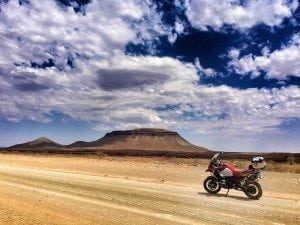Discovering Africa exotic wildlife and dinosaur fossils. Riders are thrilled when zebras or ostriches run beside us on the road. One of the most common reasons people add travel to Africa to their Bucket list is to see Africa’s exotic wildlife in their natural habitat, they want to see the “Big Five”—lions, leopards, rhinoceroses, elephants and Cape buffalo
The animals we see today are relative newcomers, however. If you’d have crossed South Africa, Namibia, or Botswana just a short time ago, say 200-million years, imagine who you could have shared the space with. (There would have been no road.)

Southern Africa prehistoric dinosaur fossils
The landscape we ride through was once part of Gondwana, the original supercontinent, originating about 550-million years ago. (Several other landmasses also existed.) Dinosaurs ruled for about 120-million years, dying out approximately 65-million years ago. Dinosoar fossils and fossil prints can be seen on hikes, in museums, and in small-town collections.
This was long before anything resembling humans came onto the scene. Earliest ancient humans existed between 6-million and 7-million years ago. Homo Sapiens (like us) have only been around for 200,000 years.
Picture having one of these prehistoric animals loping along beside you.
- Massospondylus. Approximately 185-million to 230-million years ago, these dinosaurs, which grew up to five meters long, roamed in great herds between what is now Southern Africa and Russia.
- Antetonitrus. This 210-million-year-old sauropod, recently found in South Africa’s Free State, weighed 2,000 kg, was eight to ten meters long, and measured 1.5 to 2m high at the hips.
- Cercopithecoides monkey. Five million years ago you might have spotted one of these giant monkeys, about twice the size of today’s velvet monkeys, weighing up to fifty kg/110 lb.
- Makapania. This massive ox-like animal, related to the present-day musk ox, lived between 3-million and 2-million years ago. Its body weight is estimated to have been about 263 kg/580 lb.
- Chalicothere. These knuckle-walking giants had horse-like heads and steeply sloping backs. Standing more than two meters (6.5”) tall. The huge claws on their front feet were likely for pulling down vegetation as they fed. They lived between 45-million and 1.8-million years ago. Their closest living relatives are horses, tapirs, and rhinos.
- Sabre-tooth cat. Named for their long blade-like upper canines. Sabre-tooth cats had relatively short but powerful front legs. They’d become extinct by about 1-million years ago. Bolt’s Farm, in South Africa, has a wealth of big-cat-fossils thought to be between 2.9-million and 4.5-million years old.
Viewing these Africa exotic wildlife and dinosaur fossils
View these now extinct animals at the self-proclaimed Cradle of Humankind, a 47,000 hectare/180 sq mi site, located about 50 km/31 mi northwest of Johannesburg. (According to existing archaeological and fossil evidence, the Cradle of Humanity, often referred to as the Cradle of Humanity, is in East Africa.)
Declared a World Heritage site by UNESCO in 1999, this South African site is best known for fossils of early hominids. Thousands of animal bones are viewable, representing a great variety of species.
Contact us if you are interested in an optional visit to this site.
Dinosaur tracks
200 million years ago, a two-legged, three-toed dinosaur left these tracks in what was likely mud around a watering hole, about 220 km/125 mi north of Windhoek, Namibia.

